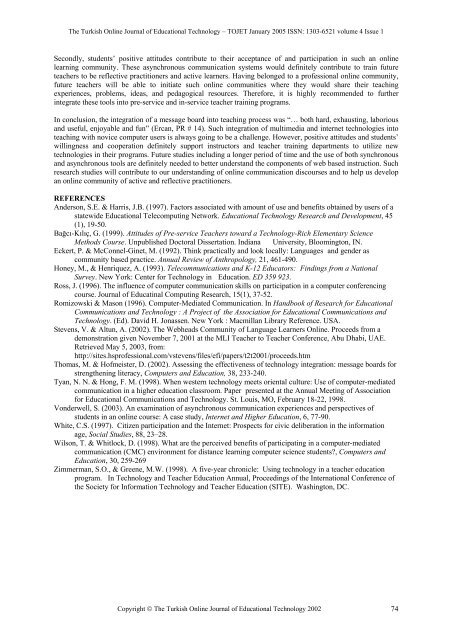Age - TOJET the Turkish online journal of educational technology
Age - TOJET the Turkish online journal of educational technology
Age - TOJET the Turkish online journal of educational technology
You also want an ePaper? Increase the reach of your titles
YUMPU automatically turns print PDFs into web optimized ePapers that Google loves.
The <strong>Turkish</strong> Online Journal <strong>of</strong> Educational Technology – <strong>TOJET</strong> January 2005 ISSN: 1303-6521 volume 4 Issue 1<br />
Secondly, students’ positive attitudes contribute to <strong>the</strong>ir acceptance <strong>of</strong> and participation in such an <strong>online</strong><br />
learning community. These asynchronous communication systems would definitely contribute to train future<br />
teachers to be reflective practitioners and active learners. Having belonged to a pr<strong>of</strong>essional <strong>online</strong> community,<br />
future teachers will be able to initiate such <strong>online</strong> communities where <strong>the</strong>y would share <strong>the</strong>ir teaching<br />
experiences, problems, ideas, and pedagogical resources. Therefore, it is highly recommended to fur<strong>the</strong>r<br />
integrate <strong>the</strong>se tools into pre-service and in-service teacher training programs.<br />
In conclusion, <strong>the</strong> integration <strong>of</strong> a message board into teaching process was “… both hard, exhausting, laborious<br />
and useful, enjoyable and fun” (Ercan, PR # 14). Such integration <strong>of</strong> multimedia and internet technologies into<br />
teaching with novice computer users is always going to be a challenge. However, positive attitudes and students’<br />
willingness and cooperation definitely support instructors and teacher training departments to utilize new<br />
technologies in <strong>the</strong>ir programs. Future studies including a longer period <strong>of</strong> time and <strong>the</strong> use <strong>of</strong> both synchronous<br />
and asynchronous tools are definitely needed to better understand <strong>the</strong> components <strong>of</strong> web based instruction. Such<br />
research studies will contribute to our understanding <strong>of</strong> <strong>online</strong> communication discourses and to help us develop<br />
an <strong>online</strong> community <strong>of</strong> active and reflective practitioners.<br />
REFERENCES<br />
Anderson, S.E. & Harris, J.B. (1997). Factors associated with amount <strong>of</strong> use and benefits obtained by users <strong>of</strong> a<br />
statewide Educational Telecomputing Network. Educational Technology Research and Development, 45<br />
(1), 19-50.<br />
Bağcı-Kılıç, G. (1999). Attitudes <strong>of</strong> Pre-service Teachers toward a Technology-Rich Elementary Science<br />
Methods Course. Unpublished Doctoral Dissertation. Indiana University, Bloomington, IN.<br />
Eckert, P. & McConnel-Ginet, M. (1992). Think practically and look locally: Languages and gender as<br />
community based practice. Annual Review <strong>of</strong> Anthropology, 21, 461-490.<br />
Honey, M., & Henriquez, A. (1993). Telecommunications and K-12 Educators: Findings from a National<br />
Survey. New York: Center for Technology in Education. ED 359 923.<br />
Ross, J. (1996). The influence <strong>of</strong> computer communication skills on participation in a computer conferencing<br />
course. Journal <strong>of</strong> Educatinal Computing Research, 15(1), 37-52.<br />
Romizowski & Mason (1996). Computer-Mediated Communication. In Handbook <strong>of</strong> Research for Educational<br />
Communications and Technology : A Project <strong>of</strong> <strong>the</strong> Association for Educational Communications and<br />
Technology. (Ed). David H. Jonassen. New York : Macmillan Library Reference. USA.<br />
Stevens, V. & Altun, A. (2002). The Webheads Community <strong>of</strong> Language Learners Online. Proceeds from a<br />
demonstration given November 7, 2001 at <strong>the</strong> MLI Teacher to Teacher Conference, Abu Dhabi, UAE.<br />
Retrieved May 5, 2003, from:<br />
http://sites.hspr<strong>of</strong>essional.com/vstevens/files/efi/papers/t2t2001/proceeds.htm<br />
Thomas, M. & H<strong>of</strong>meister, D. (2002). Assessing <strong>the</strong> effectiveness <strong>of</strong> <strong>technology</strong> integration: message boards for<br />
streng<strong>the</strong>ning literacy, Computers and Education, 38, 233-240.<br />
Tyan, N. N. & Hong, F. M. (1998). When western <strong>technology</strong> meets oriental culture: Use <strong>of</strong> computer-mediated<br />
communication in a higher education classroom. Paper presented at <strong>the</strong> Annual Meeting <strong>of</strong> Association<br />
for Educational Communications and Technology. St. Louis, MO, February 18-22, 1998.<br />
Vonderwell, S. (2003). An examination <strong>of</strong> asynchronous communication experiences and perspectives <strong>of</strong><br />
students in an <strong>online</strong> course: A case study, Internet and Higher Education, 6, 77-90.<br />
White, C.S. (1997). Citizen participation and <strong>the</strong> Internet: Prospects for civic deliberation in <strong>the</strong> information<br />
age, Social Studies, 88, 23–28.<br />
Wilson, T. & Whitlock, D. (1998). What are <strong>the</strong> perceived benefits <strong>of</strong> participating in a computer-mediated<br />
communication (CMC) environment for distance learning computer science students?, Computers and<br />
Education, 30, 259-269<br />
Zimmerman, S.O., & Greene, M.W. (1998). A five-year chronicle: Using <strong>technology</strong> in a teacher education<br />
program. In Technology and Teacher Education Annual, Proceedings <strong>of</strong> <strong>the</strong> International Conference <strong>of</strong><br />
<strong>the</strong> Society for Information Technology and Teacher Education (SITE). Washington, DC.<br />
Copyright © The <strong>Turkish</strong> Online Journal <strong>of</strong> Educational Technology 2002 74
















